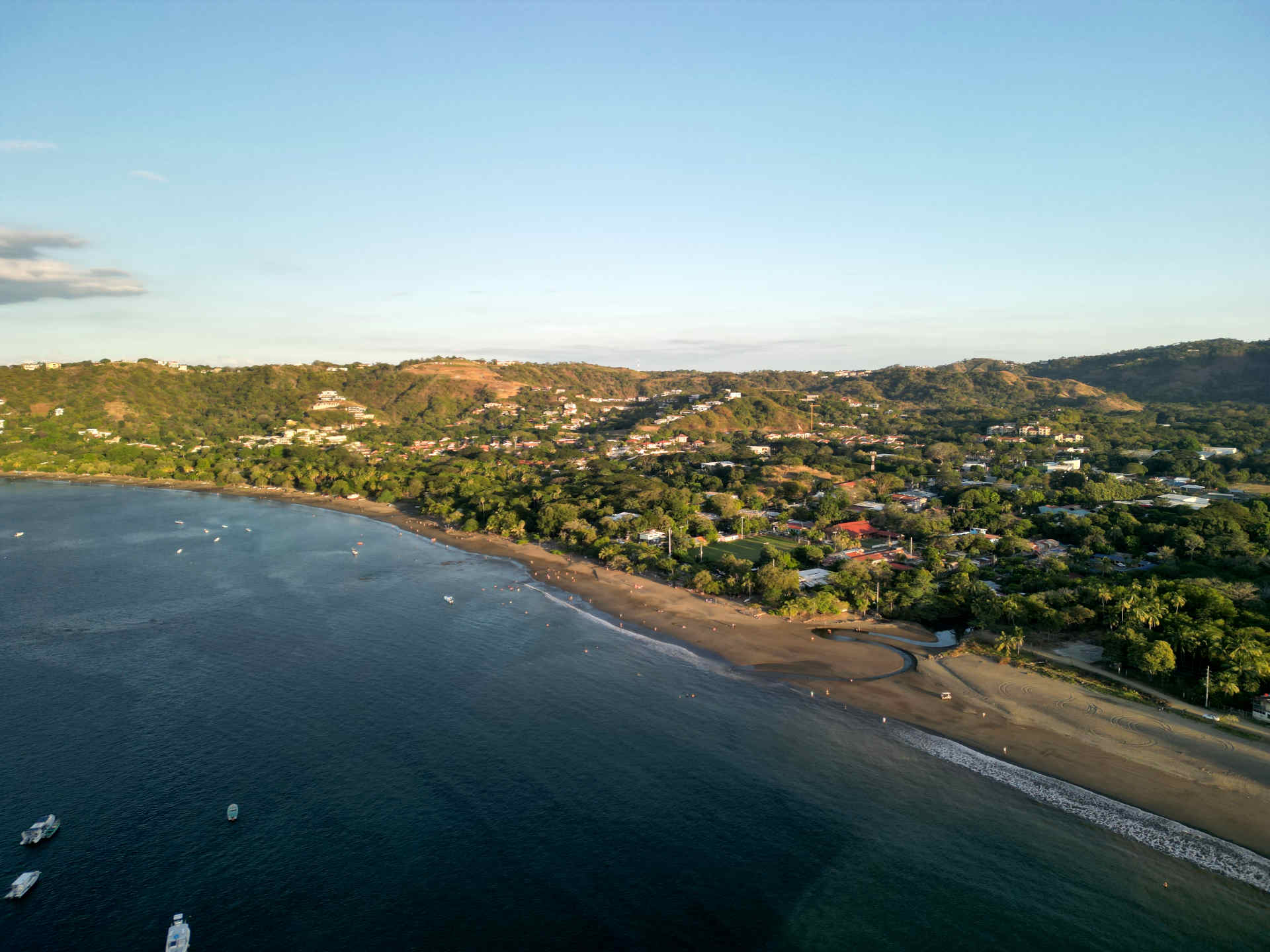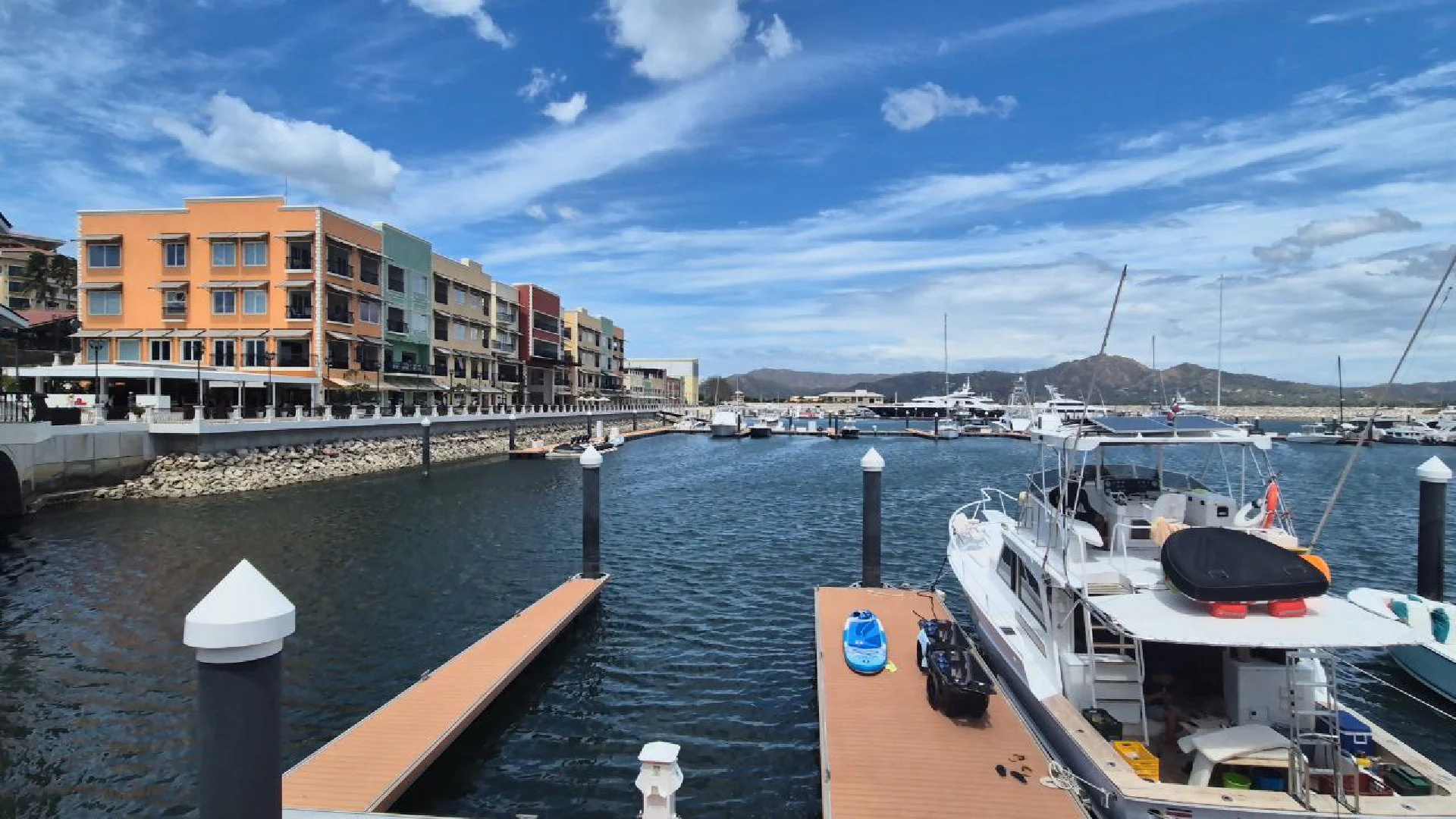The Marina de Playas del Coco project marks a turning point for this popular Guanacaste beach town, bringing new opportunities for investors and residents alike. After 24 years of planning, construction has finally begun on what will become Costa Rica’s seventh marina, with a substantial $24.5 million investment that promises to transform the local real estate landscape and economy over the next 3-5 years.
Located in the Municipality of Carrillo, this ambitious development will feature 299 berths for vessels between 12 and 40 meters, making it the main port in the North Pacific region. The project extends beyond just docking facilities, with plans for administrative offices, commercial areas, maintenance facilities, and other amenities that will create a complete maritime hub and boost both tourism and property values in the surrounding area.
After years of talk and planning, the Marina de Playas del Coco is finally happening. Construction crews broke ground in early 2025, kicking off what locals have waited over two decades to see. This 25-hectare project isn’t just a place to park boats – it’s set to become the main port for the entire North Pacific region of Costa Rica. Right now, you’ll see workers building the access road and preparing the waterways. The path to get here wasn’t easy. For 24 years, this marina idea bounced between planning stages and shelved dreams. Economic downturns and paperwork hurdles kept pushing it back. Now that it’s moving forward, El Coco (as locals call it) will join places like Papagayo and Flamingo as one of Costa Rica’s key marina stops.Marina de Playas del Coco: Project Overview
Timeline and Current Status
If you drive by the site today, you’ll spot heavy machinery and construction activity – a welcome sight after so many false starts. Asodemac, the development association behind the project, secured $24.5 million to fund the work, with completion expected somewhere between 2028 and 2030. The work is happening in stages, with crews focusing first on building a proper access road. Every step requires approval from Cimat, the government commission that oversees marina projects. They’re keeping a close eye on everything from water quality to engineering standards. For locals who’ve heard “the marina is coming” for years, seeing actual construction makes this feel real for the first time.
Photo of the beach line in Playas del Coco. This is the central beach strip, with the marina planned for south of this area.
Facilities and Capacity
When finished, the marina will hold 299 boats ranging from 40-foot sailboats to 130-foot luxury yachts. That’s a game-changer for this stretch of coastline, which currently lacks proper facilities for larger vessels.
The plans go way beyond just docks. Boat owners need fuel, maintenance, and storage – all included in the design. There will be repair shops, administration buildings, and fueling stations. You’ll also find commercial areas with shops and services, plus parking for visitors. All these elements create a complete package that both serves boat owners and creates a new attraction for El Coco.
Investment and Development Partners
The $24.5 million backing this project comes through Asodemac, which stands for Association for the Development of the Marina del Coco. They’ve pushed this vision forward through countless meetings, permit applications, and planning sessions.
Getting this far required teamwork between local officials in Carrillo, the Costa Rican Tourism Institute (ICT), and various environmental agencies. While similar to other marina projects in Costa Rica, this one fits specifically with what El Coco needs. The effort shows how public and private groups can work together on major infrastructure that benefits an entire region.
Walk around El Coco these days and you’ll hear the buzz – the marina project has people talking and prices climbing. Land that sold for $100,000 in 2020 might fetch $500,000 today. And that’s before a single boat has docked at the new marina. Real estate agents who used to nap through the afternoon now juggle multiple clients and phone calls. The change feels dramatic for longtime residents. El Coco was always a beach town where people dropped by for the day, had some food, enjoyed the water, and headed home. Now you’re seeing serious investors walking the streets, taking measurements, and planning for the future. Restaurant owners are finally fixing up those rusty ceiling fans and adding new menu items. It’s like the whole town just got a shot of energy.Economic Impact on Playas del Coco
Real Estate Growth and Opportunities
“Do you have anything near the marina?” That’s the first question real estate agents hear these days. Places like Coco Bay and Pacifico are seeing homes sell sometimes in a single day. If your property has a view of the construction site, you’re sitting on gold – well, future gold anyway. The smart money moved in early, but there’s still plenty happening. Check out the construction crews working on renovations throughout town. That tired-looking condo complex from 2005? It’s getting a complete makeover with high-end finishes. That empty lot that sat ignored for years? There’s now a sign advertising luxury townhomes coming soon. Buyers who can’t afford Tamarindo or Flamingo prices are discovering El Coco offers similar potential at lower entry points. A decent two-bedroom condo still starts around $250,000, while beachfront will run you upwards of $800,000. The marina mention in property listings practically guarantees extra calls.
Nearby beach town – Playa Flamingo, has seen a huge uptick in development and infrastructure with the completion of their marina.
Tourism Boost and Business Development
Local tour operators used to close shop during green season. Now they’re staying open year-round and buying new boats. Fishing charter captains are upgrading equipment. That sleepy dive shop on the corner suddenly has new signs and extended hours. Everyone’s preparing for the wave of marina traffic that’s still years away.
The boom spreads beyond the obvious water-based businesses too. The hardware store can’t keep certain items stocked. Hotels that normally had 50% occupancy in September are suddenly full of people coming to scout real estate. Even the grocery stores are expanding their wine selections and adding imported foods. Drive through Sardinal or Filadelfia and you’ll notice new lunch spots catering to construction workers. The morning traffic heading into El Coco includes not just tourists but suppliers, contractors, and service people – all signs of a local economy on the move.
Job Creation and Local Economy
For local families, the most welcome change is the “Help Wanted” signs appearing in windows. The construction site alone employs over 200 people, from heavy equipment operators to the security guards who watch the fence line. Looking ahead, the marina will need dock staff, maintenance crews, office workers, and dozens of other positions – estimates suggest at least 500 permanent jobs.
This couldn’t come at a better time. Recent studies showed troubling poverty rates in coastal communities, with many local families struggling to keep up with rising costs. The job boom helps balance the housing crunch. Monthly salaries are increasing too, with skilled construction workers now earning $800-1000 monthly instead of the $600 that was standard before. Community leaders have convinced developers to run training programs so locals can qualify for better positions. At the town hall last month, even longtime marina critics admitted the project is bringing needed paychecks to families who’ve lived here for generations.
Playas del Coco as an Investment Destination
Smart money always looks for the right timing, and El Coco’s investment clock is definitely ticking. Five years ago, you could still find oceanview lots for reasonable prices. Two years ago, those same lots had doubled. Today, they’re hard to find at any price. The marina project has shifted this beach town from “maybe someday” to “buy now” for many investors.
What makes El Coco different from other marina towns like Flamingo or Los Sueños is its accessibility and infrastructure. You’re just 30 minutes from Liberia’s international airport, with direct flights from major U.S. and Canadian cities. The town already has supermarkets, medical clinics, and good cell service. These practical details matter when you’re considering where to put your money in Costa Rica.
Property Market Trends
The numbers tell quite a story. That 400% price jump between 2020 and 2023 wasn’t evenly spread across all properties. Beachfront has always commanded premium prices, but now the “golden zone” includes anything within a 15-minute walk of the marina site. Pre-construction condos in this area start around $350,000 for two bedrooms, while existing homes need serious updating but sell for land value.
Rental returns are changing too. What used to be a $1,000 monthly rental now goes for $1,800, especially if it’s furnished well. Short-term vacation rentals see even better numbers, with marina-view properties already advertising future dock access in their Airbnb listings. Property managers report occupancy rates climbing from 60% to nearly 85% year-round. For investors wanting both appreciation and income, these trends point to continuing strength in the market.
Comparative Analysis with Other Guanacaste Locations
“We looked at Tamarindo and Flamingo first, but the prices were just too high,” says a common refrain from new buyers in El Coco. This price difference is real. Comparable properties in Tamarindo often run 30-40% higher than in El Coco, while Flamingo can be double the price for beachfront.
The marina gives El Coco something these other areas don’t have or are still developing. Flamingo’s marina opened recently but with fewer berths. Tamarindo has no marina at all. The 299 berths coming to El Coco put it in a different category altogether. Travel times also favor El Coco – you’ll reach the Liberia airport in 30 minutes versus 60+ from Tamarindo. For investors weighing all factors, El Coco offers a sweet spot of reasonable entry prices, strong growth potential, and practical advantages in location.
Foreign Investment Considerations
American and Canadian buyers dominate the market, making up nearly 70% of foreign purchases. The process isn’t complicated – foreigners have the same property rights as locals in Costa Rica, though beachfront requires special concessions. The $24.5 million marina investment signals government support for development in this region, giving buyers confidence in the regulatory environment.
Financing works differently here, however. Local banks rarely lend to foreigners, so most purchases are cash or involve seller financing. Property taxes remain surprisingly low – about 0.25% of registered value annually. For North Americans used to tax bills in the thousands, paying $500-1,000 yearly feels like a bargain. The bigger expense is the 13% transfer tax when buying, which buyers and sellers sometimes split. Those considering investment should also budget for property management, as absentee ownership requires local help with maintenance and rentals.

Beach very close to Playas del Coco – Calzon de Pobre. This beach is less busy than Coco and great for snorkeling.
Living in Playas del Coco
El Coco isn’t just for investors – it’s home to a growing community of expats and locals who appreciate its laid-back vibe and practical amenities. Unlike some beach towns that empty out during green season, El Coco maintains a year-round population. You’ll find locals who’ve been here for generations alongside newcomers from North America and Europe who decided Costa Rica’s pacific coast was the perfect place to start a new chapter.
The marina project is changing the character of the town, but not overnight. There’s still that friendly feeling where the grocery store clerk remembers your name, and you’ll run into the same people at coffee shops and beach walks. What is changing is the level of services available – new restaurants, improved internet, and better healthcare options make daily life more comfortable than it was even five years ago.
Lifestyle and Amenities
Your typical day in El Coco might start with a beach walk at sunrise when temperatures are pleasant and the sand is quiet. By 8 AM, coffee shops along the main street are bustling with a mix of tourists and locals. Midday heat sends most people indoors or poolside, while afternoons bring families back to the beach and sunset gatherings at the numerous beach bars.
Practical needs are well-covered here. Two major supermarkets stock everything from local produce to imported goods. There’s a pharmacy, hardware stores, and plenty of shops for basic needs. Medical care is available at the local clinic, with more complex services just 30 minutes away in Liberia. The cell service is reliable, and fiber internet has reached many neighborhoods, making remote work entirely feasible. Water supply can be spotty during peak dry season, but most newer developments include backup systems. Overall, El Coco offers one of the more comfortable lifestyle options in Guanacaste without the premium prices of other beach towns.
Transportation and Accessibility
Getting to El Coco is straightforward. From Liberia International Airport, it’s a 30-minute drive on good roads. If you’re coming from San José, expect a 4-hour journey by car, or you can catch a 45-minute domestic flight to Liberia. For those without a car, public buses connect El Coco to Liberia several times daily for about $2 each way.
Within town, many residents use golf carts for daily transportation – they’re perfect for the short distances and easy to park. Walking works well for the central areas, though midday heat makes shade a precious commodity. Taxis are plentiful, and ride-sharing services operate in the area. For trips to other beach towns, you’ll want a car – preferably with high clearance for the occasional rough road. The drive to popular spots like Tamarindo takes about an hour, while Flamingo is just 30 minutes away. The new marina access road, once completed, will improve connectivity to the northern part of town.
Community and Social Environment
“I came for the beach but stayed for the people” – that’s a phrase you’ll hear from longtime residents. El Coco has a more diverse community than some tourist areas, with a solid core of Costa Rican families alongside the expatriate population. This mix creates a more authentic feel than in some expat enclaves.
Social life centers around beach activities, restaurants, and community events. There’s a weekly farmers market, beach clean-ups organized by local environmental groups, and impromptu gatherings for sunset. Spanish-English language exchanges happen at coffee shops, and several active Facebook groups keep everyone connected. Schools in the area include both public options and private bilingual academies, making El Coco viable for families. While the nightlife isn’t as intense as Tamarindo’s, there are enough bars and restaurants to keep evenings interesting. The marina project will likely expand these social options, with plans for waterfront dining and gathering spaces as part of the development.
Frequently Asked Questions
As the marina project progresses, we’re getting lots of questions from potential investors and residents. Here are straightforward answers to the most common questions about the Marina de Playas del Coco and what it means for the area.
When will the marina be completed?
Based on current projections, the Marina de Playas del Coco should be finished sometime between 2028 and 2030. Construction began in early 2025 and is proceeding in phases. The first phase focuses on the access road and basic infrastructure. You can see active construction if you visit the site today, though the project still has several years to go before boats can dock.
How will the marina affect property values?
Property values have already increased significantly, with a 400% jump between 2020 and 2023. This trend is likely to continue as construction progresses. Properties within walking distance of the marina site are seeing the biggest price increases. While nobody can predict exact numbers, similar marina projects in Costa Rica have consistently pushed up both property values and rental rates in surrounding areas.
Can foreigners buy property in Playas del Coco?
Yes, foreigners have essentially the same property rights as Costa Ricans, with some exceptions for beachfront property. You don’t need to be a resident to purchase property. Most foreign buyers use a Costa Rican corporation to hold their property, which can provide certain legal and tax advantages. Always work with a reputable lawyer who specializes in real estate transactions for foreigners.
What’s the best area to invest in Playas del Coco?
The “golden zone” is currently anything within a 15-minute walk of the marina site. This includes parts of the main beach road and the Ocotal area. For long-term investment, properties with actual or potential views of the marina are commanding premium prices. For better value, look slightly further out in neighborhoods like Coco Bay, where you still get the benefits of the marina without the premium pricing of beachfront locations.
How does Playas del Coco compare to other beach towns in Guanacaste?
Compared to Tamarindo or Flamingo, El Coco offers more affordable entry points for real estate while providing similar amenities. It’s closer to the international airport (30 minutes vs. 60+ for Tamarindo). The marina will give El Coco a significant advantage over beach towns without marinas. El Coco also maintains a more authentic Costa Rican feel, with a year-round local population and a good mix of tourists and residents.
What about infrastructure concerns like water and electricity?
El Coco has generally reliable utilities, though water can be limited during peak dry season (February-April). Most newer developments include backup water systems. Electricity is stable, with occasional brief outages during heavy storms. Internet service has improved dramatically, with fiber connections now available in many areas. The marina project includes infrastructure upgrades that should benefit the broader community, including improved water management systems.


